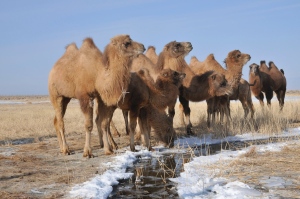Have y’all ever thought about that before? I had not! But I was reading the 2013 Best American Science and Nature Writing, edited this year by Siddhartha Mukherjee, and an essay by Michelle Nijhuis from Scientific American blew my mind out of the back of my skull. Someone has to decide which animals go extinct! Even if that is not the exact decision that gets made, it’s effectively still true: When resources are finite (and they always are), choosing to save one species means you have chosen not to save another one.
If you aren’t in denial about this truth, then your next job, as a conservation biologist, is to decide how you’re going to decide which species to save. There are some different schools of thought on this. One says, species with unique jobs or species whose existence is crucial for the survival of many other species should be our top priority. This seems pretty obvious: If all the animals in the forest depend on whitebark pine nuts for food, we should save the whitebark pines.

Except that we don’t really understand ecosystems all that well, and we might choose wrong. Another idea is to save weird endangeredspecies, ones with few close relatives. We can probably let go of the ashy stormy petrel, because there are lots of different kinds of stormy petrels that are almost exactly the same. But Bactrian camels and Chinese salamanders don’t come from big families, so this theory suggests that we should make those a conservation priority.

Another idea is that we should pick ecosystems we really like, and save those in toto. It’s all very controversial, and everyone gets really upset when we start talking about letting species die (cause that is upsetting), so let’s leave that behind and move on to the other article from this collection that I wanted to talk about, which discusses a wonderfully crazy concept called rewilding.
I can’t do justice, actually, to this one. It’s too nuts. You can read the whole article here and you should because it’s interesting, but I will just share the passage I liked the best:
In an article published in the journal Nature, the group [of scholars] presented a plan for what it called “Pleistocene rewilding.” When humans arrived in North America . . . they killed off most of the continent’s large mammals, leaving key ecological roles unfilled. The Pleistocene rewilders proposed finding substitute animals that could serve in their place. For instance, African or Asian elephants could be let loose to make up for the long-lost woolly mammoth.
The authors . . . envisioned a series of small-scale experiments leading up to the creation of “one or more ‘ecological history parks’,” which would cover “vast areas of economically depressed parts of the Great Plains.” In these huge “history parks,” elephants, camels, and African cheetahs — to replace the missing American cheetah — would roam freely.
Ahahahahaha, I love this idea so much (though I’d like the people who came up with this plan to just watch Jurassic Park real quick to get a feeling for what might go wrong). Oh SCIENCE. What did we ever do to deserve you?